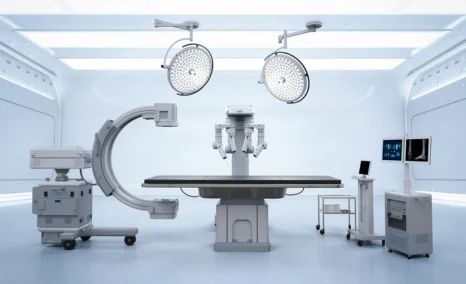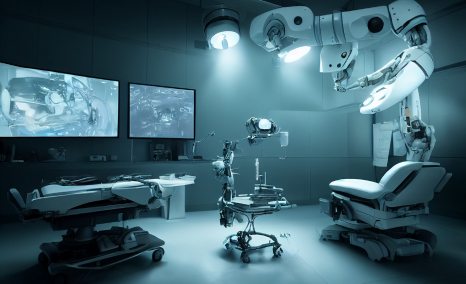How Augmented and Virtual Reality Are Transforming the Healthcare Market Dynamics?
Jun 06, 2025
Table of Contents
The implementation and adoption of new-age technologies such as augmented and virtual reality in healthcare are driving innovation and shaping the future of the medical field. While AR and VR are not new concepts, the past few years have witnessed tremendous advances, powered by improvements in camera and sensor technologies, as well as AR and VR healthcare solutions and software platforms.
Industries such as manufacturing, architecture, education, tourism, and gaming have already embraced AR and VR, and now the healthcare sector is experiencing a similar surge in adoption. Augmented reality in healthcare is enabling interactive, immersive patient education and enhancing care experiences. Meanwhile, virtual reality in healthcare is transforming medical training, providing advanced simulation-based learning for doctors and professionals, ultimately improving diagnostic accuracy and treatment planning.
Downloads
Click Here To Get the Article in PDF
Recent Articles
- Top healthcare innovations changing the healthcare dynamics
- Diagnostic Precision: The Rise of Medical Imaging Technologies and Market Trends
- Biosense Webster’s HELIOSTAR Radiofrequency Balloon Ablation Catheter; Philips’s ClarifEye Augmen...
- Navigating the Emerging Trends and Technologies in the Spinal Cord Injury Rehabilitation Segment
- Evaluating the Key Trends and Technologies Shaping the Future of Dentistry
For hospitals and healthcare providers, AR/VR solutions present an opportunity to not only enrich patient experiences but also drive operational efficiencies and new revenue streams. As the augmented and virtual reality in healthcare market continues to evolve, major tech players and augmented reality companies are racing to deliver next-generation AR VR healthcare solutions that will further redefine modern care delivery. With rapid innovation on the horizon, mixed reality in the healthcare market trends signal a future where immersive technologies will become integral to both clinical practice and patient engagement.
Augmented and Virtual Reality in the Healthcare Industry
Virtual Reality in healthcare refers to a computer-generated environment that provides a three-dimensional image or simulated experience to the user, offering an immersive feel of a virtual world. Users can interact with this environment through electronic equipment or 3D near-eye displays. Augmented Reality, on the other hand, merges the real world with computer-generated content, using displays, cameras, and sensors to overlay digital information and enhance the user’s experience.
Both augmented and virtual reality in healthcare have shown tremendous potential, with applications expanding rapidly and already transforming key segments of healthcare delivery. AR in healthcare is revolutionizing the way physicians interact with patients and clinical data. To meet rising healthcare demands and deliver improved solutions, AR and VR healthcare solutions are becoming valuable tools for providers, professionals, and patients alike.
Currently, augmented reality in healthcare is widely used for doctor and patient education, disease simulation, surgical visualization, and in critical care scenarios. Surgeons now leverage medical device augmented reality to access 3D overlays of veins, organs, and diagnostic data, enhancing surgical precision. Additionally, AR enables real-time simulation-based surgeries, eliminating the risks associated with live patients.
Looking ahead, the role of AR and VR in healthcare is set to expand, driven by growing adoption of connected devices, increasing investments, and advancements in AR VR healthcare solutions. The ongoing demand for improved diagnostic and treatment technologies is accelerating the integration of these tools across the healthcare ecosystem. Moreover, supportive government policies aimed at healthcare digitization are further fueling the growth of augmented and virtual reality in the healthcare market.
Major Uses/Applications of Augmented and Virtual Reality Benefits in the Healthcare Market
Augmented and Virtual Reality have several applications in the healthcare domain. Some of the major evolving applications include:
Medical Education and Training Using Augmented and Virtual Reality
Providing and delivering simulation-based medical education/training to healthcare professionals is among the key applications. It is observed that AR and VR can provide much more profound insight into the nuances of body functions and can recreate real-life scenarios in the virtual world. The AR and VR solutions can overcome the existing challenges and provide interactive avenues to prepare medical personnel to deal with the disease and improve their ability to deliver more suitable treatment solutions.
Augmented and Virtual Reality Improving the Patient Experience
One of the significant applications of Augmented and Virtual Reality in the medical field is to improve the patient experience, provide better health outcomes, and enhance the engagement rate in every healthcare delivery mode. Virtual Reality aims to relax and stabilize the patient’s mind and is extremely useful in treating certain disorders. Over the past few years, several studies have evaluated the feasibility and efficacy of using meditative Virtual Reality to enhance the hospital experience of ICU patients. Similarly, some of the pilot studies have been conducted with different Virtual Reality devices to evaluate their effectiveness in various clinical settings.
Virtual Reality applications are getting diverse and can go as far as to take complete control of the patient’s sentiments and senses, such as sight, hearing, and feelings, which makes the environment feel incredibly genuine. Virtual Reality can be employed in the rehabilitation and therapeutic segment to reduce pain and anxiety, and in other medical procedures. Similarly, potential applications are under development to create specific environments to treat certain mental conditions, such as phobias and addictions, among others.
Augmented Reality solutions are being implemented to improve the overall patient experience and make them stay informed with the interactive information and navigation features. Augmented Reality technology can overcome certain gaps in the treatment journey and provide an update in a more engaging manner by adding pop-up information and other interactive features.
Augmented and Virtual Reality in the Surgical Segment
VR and AR tools can display and provide interactive 2D and 3D images of physical procedures or anatomy. The Virtual Reality platform is changing the way surgeries are performed. Several major hospitals and healthcare facilities worldwide have incorporated 3D simulation-based training technologies, reflecting the rapid growth of the virtual reality market in the healthcare sector. Virtual Reality can create low-risk surgical testing environments or 3D anatomical images that provide realistic models of critical organs like the brain, heart, and eyes, among others. These VR tools in the healthcare industry help surgeons maximize efficiency and minimize risk in the operating room.
Similarly, augmented reality in healthcare provides real-time medical references and information to the surgeon. The adoption and implementation of augmented reality for healthcare can accelerate surgical operation prep times and reduce additional resource requirements and associated staff costs. This showcases the impact of AR VR healthcare solutions that are transforming surgical workflows.
The augmented and virtual reality in the healthcare market is poised to save significant time and money, fundamentally changing the dynamics involved in surgical procedures such as planning, practice, and execution. The growing adoption of medical device augmented reality and mixed reality solutions for healthcare highlights the ongoing changes in healthcare driven by these immersive technologies.
Evolving Role of AR and VR in Diagnostic Imaging and Risk Assessment
Diagnostics and accurate risk assessment of a disease’s signs and symptoms are among the most crucial aspects of the treatment journey, ensuring effective and safe health outcomes. Virtual Reality in healthcare is increasingly used to visualize patient-critical information, enhancing overall visual control, establishing quantitative correlations, and aiding surgical planning. These advancements reflect the expanding virtual reality market in the healthcare sector and its role in improving diagnostic precision.
Similarly, augmented reality in healthcare plays a pivotal role in the diagnostics segment. Many diseases can be detected, prevented, and treated more effectively with the adoption of ar in healthcare technologies. The evolving role of augmented reality for healthcare in the treatment journey starts with integrating data from various sensors into a unified, coherent interface and extends to investigating likely causes for a patient’s condition. AR tools help consolidate and visualize comprehensive patient information, such as symptoms and diagnostic test results, enabling physicians to “see through” different body parts and structures more clearly.
For example, in oncology, AR and VR healthcare solutions assist in rendering detailed information related to cancer patterns, supporting qualitative assessments of tumor shape and margin changes over time. This illustrates how AR and VR in healthcare contribute to more accurate diagnostics and personalized treatment planning.
With ongoing technological innovation, the mixed reality in the healthcare market is projected to grow, and Augmented Reality is expected to significantly improve diagnostic accuracy in the near future. Several promising AR VR health solutions currently under development aim to perform diverse tests and simulations using real-time data analytics, extracting valuable insights for research and clinical applications. However, it is essential to carefully evaluate the potential advantages and challenges of virtual reality and augmented reality in healthcare before widespread deployment, as these remain relatively novel technologies.
Augmented and Virtual Reality for Data Visualization and Body Mapping
Virtual Reality, Augmented Reality, and Mixed Reality are advanced 3D visualization technologies capable of interacting with microscopic images, molecular data, and detailed anatomical datasets. These immersive technologies provide in-depth visualization and enhance the comprehensibility of complex biological system processes, holding significant potential for full-body mapping and improving medical operations. In cases where medical issues are complicated or the doctor cannot be physically present for an examination, these technologies enable the creation and examination of a complete digital reproduction of the patient’s physique.
With digital extended reality, it becomes possible to demonstrate and showcase critical cell biology concepts, multiplexed proteomics images, and surgical data, such as that used in heart operations. This aligns with the growth of mixed reality in the healthcare market, which is rapidly advancing to integrate such sophisticated visualization capabilities into clinical practice. Additionally, augmented reality in healthcare allows the direct projection and comparison of vital stats on the patient’s body via advanced devices, effectively highlighting problematic areas and displaying relevant real-time information.
Together, AR and VR healthcare solutions are transforming diagnostics and treatment by enabling clinicians to better understand and recognize patterns in patient data through live stats and interactive 3D models. This integration is part of the broader AR VR healthcare trend that promises to elevate precision and efficiency in healthcare delivery.

Leading Companies in the Augmented and Virtual Reality Market
Globally, several major tech giants are actively working in the market to deliver various augmented and Virtual Reality-based innovative solutions. Some of the key players in the segment include Microsoft, Magic Leap, Meta, Groove Jones, Google, Niantic, EON Reality, Oculus VR, Unity, Quytech, Nvidia, Samsung, Hedgehog Lab, Qualcomm, Warby Parker, zSpace, Unity Software, VironIT, VR Vision Inc, The Intellify, Innovation, NEXT/NOW, iTechArt Group Inc, NextVR, and others. The demand for Augmented and Virtual reality-based healthcare products and services is anticipated to increase in the coming years. Several tech giants and startups are predicted to enter the Augmented and Virtual Reality Market in the near future to fulfill various evolving needs and grab the market share.
Augmented and Virtual Reality Future Analysis and Prospective
Augmented Reality and Virtual Reality are game-changing technologies in the healthcare industry, offering a diverse range of applications and solutions to meet the evolving needs of both patients and healthcare providers. While many current applications remain in their infancy, ongoing development and innovation are driving rapid advancements. The augmented and virtual reality in healthcare market is poised to take a significant leap forward, particularly in delivering interactive solutions for education, treatment, and beyond. The future holds immense potential for other healthcare segments as well, as the adoption of AR and VR in healthcare across various service delivery verticals is expected to transform healthcare outcomes significantly.
However, the widespread integration of these technologies faces several technical and non-technical limitations. Challenges include a lack of clinicians’ knowledge, limited awareness about augmented reality in the healthcare industry, the absence of suitable standards, insufficient infrastructure, and gaps in organizational culture and management support. Addressing these barriers is crucial for the successful and proper implementation of AR VR healthcare solutions across healthcare systems.
Governments worldwide are increasingly prioritizing healthcare digitalization, formulating favorable policies, and launching initiatives to promote the adoption of new technologies. Simultaneously, tech giants and augmented reality companies are focusing on resolving ground-level challenges with innovative AR VR health solutions. The growth of virtual reality in the healthcare market and in healthcare is being further fueled by this collaborative effort between public and private stakeholders.
The future prospects of augmented reality and virtual reality in healthcare look exceptionally promising, offering immense potential for every stakeholder within the healthcare ecosystem—from clinicians and patients to technology developers and policymakers.
Downloads
Article in PDF
Recent Articles
- Diagnostic Precision: The Rise of Medical Imaging Technologies and Market Trends
- 8 Promising Technologies Powering a More Efficient Operating Room
- Evaluating the Key Trends and Technologies Shaping the Future of Dentistry
- Top healthcare innovations changing the healthcare dynamics
- Navigating the Emerging Trends and Technologies in the Spinal Cord Injury Rehabilitation Segment



